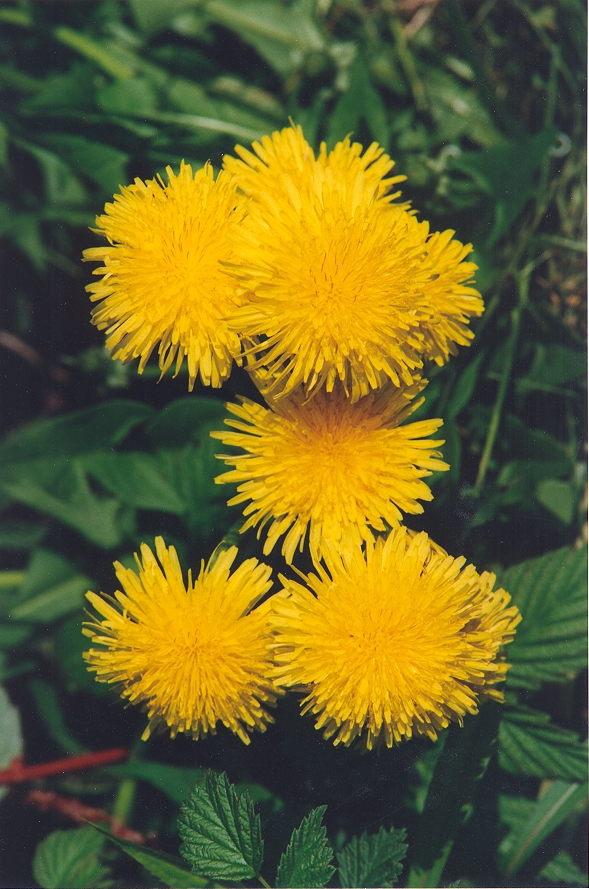
-
- Everybody knows what a dandelion looks like. What appears as one brilliant yellow flower at the top of a long hollow stem, is in fact many small flowers which spring forth from a small disk. (Notwithstanding this very showy flower, the dandelion reproduces itself wholly non-sexually and does not require the visits of insects.) The stem arises from a rosette of basal leaves. The leaves are jagged and its the leaves from which the plant gets its name, in French, "dent de lion," lion's teeth. Note the "reflexed sepals" below the flower head. And, as all children know, the stems when broken exude a milky substance which will dry as black smudges on the hand. And, too, who hasn't blown the tiny parachutes off, into the air, from the round, fluffy, translucent seedballs of the dandelion. There are, seemingly, two types: the one smaller and close to the ground, and the other taller and erect, more often found in the open wild and not hiding down amidst the grass of your front lawn. The dandelion was introduced by Europeans. Dandelions are one of the first wild flowers we see and thrive in Nova Scotia through the entire growing season. Seemingly they will grow everywhere, especially on people's lawns.
Edibility: The young leaves -- before the flower blooms, and, only if picked away from where people spread their poisons -- make a very tasty and healthy meal: "... very nutritious, containing Vitamins A, C; thiamine, riboflavin, calcium, sodium and potassium." So, Dandelion greens can be treated much like spinach, cooked or raw. They may, however, prove to be a bit bitter; so, like brussel sprouts or fiddle heads (fern sprouts), they should be soaked for an hour or so in water after being sprinkled with baking soda; rinse well with cold water in a colander before cooking.
Roots can be dried and used as a coffee substitute. (See Griffin.)
"The young roots, dug before the last frost of spring, make a good cooked vegetable. To prepare them, peel, slice and boil in two waters with a pinch of baking soda. These roots can also be made into a coffee. They can be dug any time of the year for this. Just roast them for four hours, grind them into small pieces and perk in boiling water, and you've got a good drink." (McLeod, p. 34.)
Wine can be made out of the flowers. A recipe can be found in McLeod (p. 34).
Reference earlier was made to the flower stems which when broken exude a milky substance, according to Clevely this, while temporarily staining the skin, soothes burns and stings.
- Everybody knows what a dandelion looks like. What appears as one brilliant yellow flower at the top of a long hollow stem, is in fact many small flowers which spring forth from a small disk. (Notwithstanding this very showy flower, the dandelion reproduces itself wholly non-sexually and does not require the visits of insects.) The stem arises from a rosette of basal leaves. The leaves are jagged and its the leaves from which the plant gets its name, in French, "dent de lion," lion's teeth. Note the "reflexed sepals" below the flower head. And, as all children know, the stems when broken exude a milky substance which will dry as black smudges on the hand. And, too, who hasn't blown the tiny parachutes off, into the air, from the round, fluffy, translucent seedballs of the dandelion. There are, seemingly, two types: the one smaller and close to the ground, and the other taller and erect, more often found in the open wild and not hiding down amidst the grass of your front lawn. The dandelion was introduced by Europeans. Dandelions are one of the first wild flowers we see and thrive in Nova Scotia through the entire growing season. Seemingly they will grow everywhere, especially on people's lawns.

|

|

|
_______________________________
Found this material Helpful?
_______________________________[INDEX TO WILD FLOWERS OF NOVA SCOTIA]
[UP]
[NATURE JUMP PAGE]
[HOME]
_______________________________Peter Landry
2011 (2019)